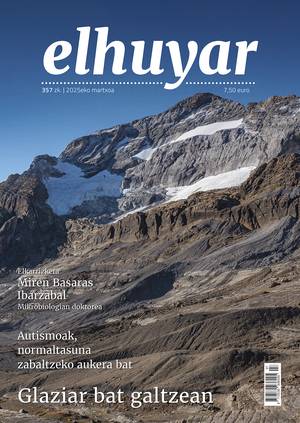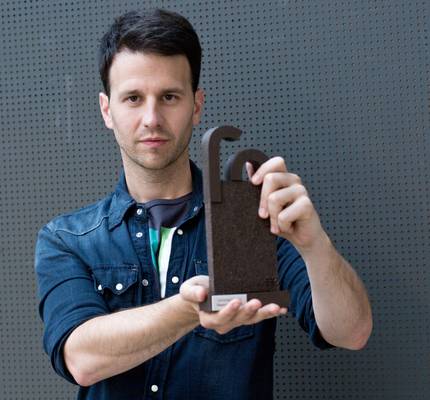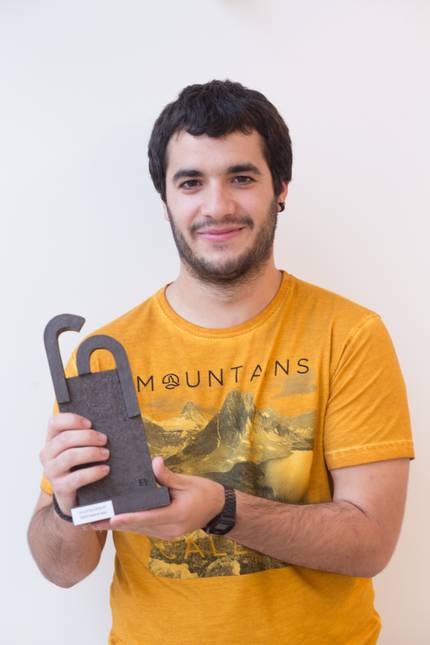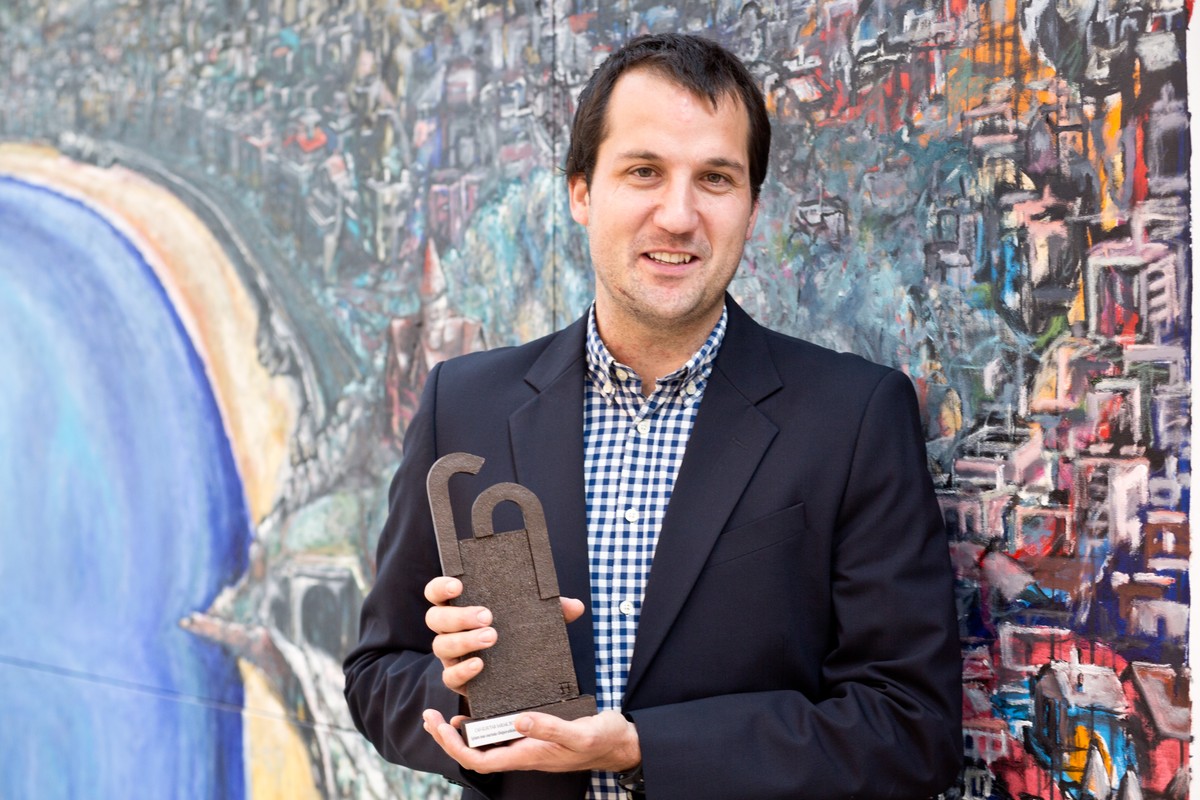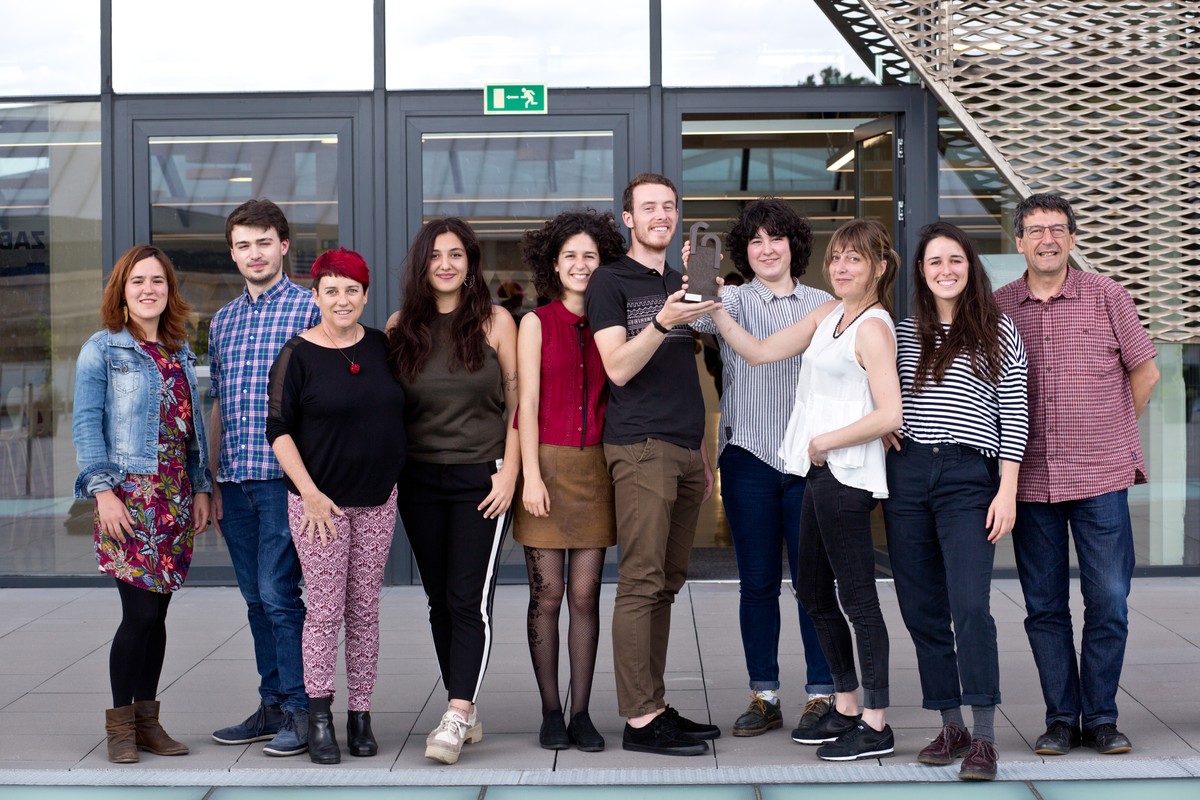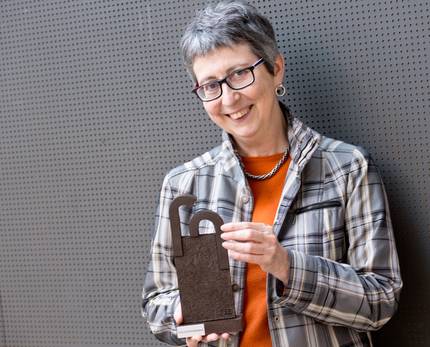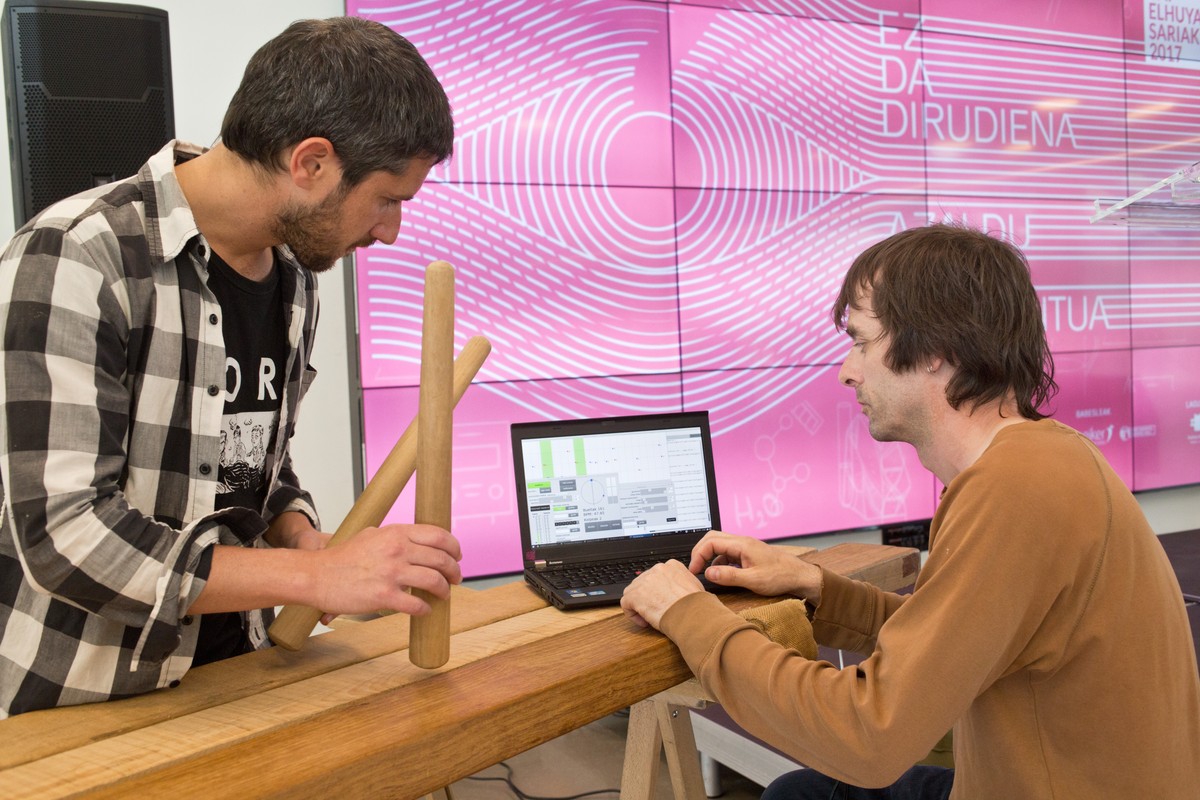This afternoon the CAF-Elhuyar 2017 awards have been awarded
This afternoon Tabakalera has been filled with scientists. It has become a meeting point for scientists, journalists and artists, and has been shown to be closer to what seems to be among them. As every year, the awards have aimed to recognize the work of those who make an effort to integrate science and technology.
The winners of this year's CAF-Elhuyar awards have been:
Award for the best general outreach article: “Illuminating the dark paths of intuition,” Gorka Azkune Galparsoro.
Prize for articles based on the author's thesis: “Streamline communications between networks: algorithms that find the optimal way”, Josu Doncel Vicente.
NEIKER-Tecnalia Primary Sector Award: “A summer with sheep following his instinct,” Mikel Etxeberria Okariz.
Journalism Award: “Cancer and its metastasis”, by Xabier Monasterio Torre.
Fellowship of creation in scientific society: Project “Arminorain 2017”, Arminorain Animation Group.
Elhuyar Award: María Jesús Esteban Galarza, a mathematician for her work in the normalization of the Basque language and the socialization of science.
So have the presenters started: “Sometimes reality is not what it seems. It is not easy to distinguish between truth and representation. To do this, it is necessary to question the obvious, to propose other hypotheses and to carry out tests to contrast them. That is the work of scientists. By doubt, we now know more. Because they made the doubt, and then they found the truth, and then they told us that truth.”
This has been done by people who have presented themselves to the caf-elhuyar awards. They have dared to give their point of view.
Solving the dark paths of intuition
The prize for the general informative article has been for Gorka Azkune Galparsoro with an article on artificial intelligence: “Illuminating the dark paths of intuition.” Azkun (Azpeitia, 1982) presented his doctoral thesis on artificial intelligence last year and currently works as a researcher at the Deusto Tech Institute, deepening research in the same field.
The jury has considered a current issue and what it will say. Highlights that the article is very well written. The author is already known in the CAF-Elhuyar awards, as he has won several times.
This is what Azkun says in his work: "The great physicist Albert Einstein said that the only thing that really is worth is intuition. In addition to Einstein, it seems that everyone else sees a huge capacity of intuition behind scientists, politicians and all kinds of top strategists. We could say that to solve complex problems, intuition is essential, along with reasoning and knowledge. But what is intuition? Is it a special power that we only have human beings? ". And to address reflection, it has departed from the learning of machines and decision-making.
When he receives the award, Azkun has had moving words for his mother. Thank you that you have always helped you advance in what you believe, you have always been by your side. She also acknowledges that the award has reached her mother late.
A summer with sheep following his instinct
This year the NEIKER-Tecnalia Award has been presented for the first time to the best work in the primary sector. The prize went to Mikel Etxeberria Okariz, a native of Beasain, with the article “A summer with sheep following his instinct”. Etxeberria is a biologist and currently studies Master in Ecology in Madrid. He is also dedicated to dissemination, writing on the blog EuskalNatura since 2016.
Etxeberria has also referred to her husband in her work: "Since the first shepherds brought sheep to the Basque Country, they have spent thousands of years adapting to their surroundings. The best adapted sheep have left more descendants, so the sheep we have today know perfectly the environment in which they live. In other words, they have modeled their instinct to survive as best as possible in Euskal Herria. Thanks to their instinct, although they continue in the countryside when it rains, when the hail arrives, they put themselves in shelter, either in the stable or under a rock. But they also follow their instinct to eat? What habitat do they choose? Or instead of choosing, do they eat what they have in front? ".
The jury highlighted that the selected work perfectly combines the two aspects considered in this contest: the scientific content on the one hand and the ability to count on the other.
Streamline communications between networks: algorithms that find the optimal way
The prize for the divulgation article based on the author’s doctoral thesis was for getxotarra Josu Doncel Vicente, with the work “Accelerating communications between networks: algorithms that find the optimal way”. Doncel is a doctor in mathematics and specialized in applied mathematics. After working in various research centers and French universities, he is currently professor of the applied mathematics and statistics department of the UPV/EHU.
The jury highlighted the work selected for its contextualization, for its appeal and for its language. In this way, who knows nothing about the subject can easily follow the article.
Doncel says in his work that in modern telecommunications networks it is important to send packets of information on the lighter path of the network. "However, to find the optimal way it is necessary to know the current situation of the entire network, which, unfortunately, is impossible, since we can not foresee the number of users in the network or the services that are going to request". In the article he spoke about the mathematical model called Discovery of the Optimal Way (BOA), which allows to speed up communications between sets of computers. The exercise proposed by Doncel basically consists of finding the optimal algorithm.
When he receives the award, he recognizes that his friends and family did not understand anything when they asked him about his work. For Doncel it has been a great challenge to write this and the prize has been a double satisfaction. After all, it has realized how important it is to disseminate and that others understand what scientists are doing.
Cancer and its metastasis
The work of journalists is fundamental also for the social diffusion of scientific culture. This year, in the field of scientific journalism, the Bilbao radio host Xabier Monasterio Torre was awarded for his piece entitled “Cancer and its metastasis”. Monasterio is a writer and translator and works as a presenter at Radio Villa in Bilbao.
The jury considers that on the radio there is only word, no graphics, images, etc., and yet, with the simple word, has managed to communicate the scientific content. It has also been evaluated that this piece is part of a larger project and, at the same time, the work of the speaker has been highlighted.
Monasterio has declared that the award has generated great satisfaction on Radio Bilbao, since it has been received in the celebrations of the 20th anniversary. "It is a project that is based on three pillars: on the one hand, the agreement with the Chair of Scientific Culture, which choose the topics and bring the scientists to the radio session; on the other, the Radio Bilbao itself, with a very nice working team; and, finally, the men and women who work in a silent and almost unconscious way, carrying out their research in Basque language, opening up to now unknown language. When he did, we soon realized that he was special. In such a committed and slippery subject, Badiola knew at all times to renounce all the alarms, false expectations and habitual morbidity, and gave us a terrible testimony of science."
Arminorain 2017
The Caf-Elhuyar Awards grant a grant of 5,000 euros to projects that serve as a bridge between science and society. This year the Animation team Arminorain has won with the project “Arminorain 2017”.
The Arminorain Animation Group consists of students, alumni and teachers of the Faculty of Fine Arts of Leioa, who carry out animation work. In this case, they have presented a project based on the cave of Arminorain, a work of fiction that will give life to his images.
The team consists of: Patxi Azpillaga, Bego Vicario, Usue Egia, Uxue Reinoso, Oihana Leunda, Miriam Inza, Leire Elizari, Laida Ruiz, Jugatx Astorkia, Jaione Mitxelena, Itsaso Navarro, Iris Santos, Iker Orelua, arróbon.
The jury defended the election “for its artistic character and social interest” and highlighted that it has other characteristics of interest: feasibility, teamwork, interdisciplinarity, experimental character…
When the members of the Animation team Arminorain Animazio have received the award, Bego Vicario said that "at first we conducted an investigation on various materials: how the stone, the clay and our engravings, our drawings were behaving. Now we want to make an animation with the animals that appear in these prints".
"In recent years, artistic activity and science have come very close. In short, they are very similar to the experimental ones when working. Society and science are increasingly valuing intuition. Until recently it has been underestimated, but now it is redefining. Intuition is an instant rationalization achieved through experience. In that sense, I think artists are very racist people and our work systems are also rational, but instantaneous."
Elhuyar Award of Merit
The Board of the Elhuyar Foundation awards annually the Elhuyar Award of Merits. Through it, it recognizes the work done in the normalization and socialization of the Basque language. And this year he has decided to give it to the mathematician María Jesús Esteban Galarza.
Born in Alonsotegi (Bizkaia, 1956), he has long lived in Paris as a researcher at the CEREMONY Applied Mathematics Research Centre. He graduated in Mathematics from UPV and was a pioneer in the use of Basque in this field. After completion, he moved to Paris where he made his doctoral thesis. Since 1981 he is a researcher at the French Research Centre and has been chairman of the Applied Mathematics Committee of the European Mathematical Association. He is also a member of Jakiunde and honorary doctor by the University of the Basque Country.He has been appointed president of the International Council of Industrial and Applied Mathematics (ICIAM). Your resume is tremendous and are just a few examples of the work done and the denominations received.
The president of the Elhuyar Foundation, Txema Pitarke De La Torre, has defined it: “Mary Jesus Stephen is one of the people who questions what seems; one of those who, to know more or understand better, asks and seeks possible answers. At that time when she became a little Basque at the university, María Jesús worked hard to do mathematics in Basque and participated in various initiatives.” He wrote with other women the first book of mathematics in Basque at university level.
“The CAF-Elhuyar Prize for Merits 2017 has been awarded for the contributions made to mathematics in his career, especially in the technical field, and especially for his pioneering role in the use of the Basque language in those times when mathematics was not carried out in the Basque language, as well as for the important heritage deposited in those early years.”
The award has served Esteban to back in time: "Young people do not believe what situation there was in the university 40 years ago. At that time we began to think that mathematics could be taught in Basque, but we realized that there was no lexicon. In the ikastolas had worked the lexicon, but for the university level we did not know how to say so many concepts. Then we started to think that we would have to start writing books and working on vocabulary, and in that we started working two groups: a group in Donostia -Elhuyar– and another in the Faculty of Sciences -Leioa-. At that time Joxerra Etxebarria was a very important person for us. Then we started working the vocabulary of mathematics by a group of 6 girls. It was a great job because we wanted to work the words of all fields of mathematics. Those years were very nice, because everything was to be done. It was a great job, but we did it with illusion."
To end the party, the txalaparta
After the awards ceremony, the author, Enrike Hurtado Mendieta, has shown the result of the project that last year received the scholarship of creation in Sociedad de la Ciencia: “Digital and interactive txalaparta”.
Hurtado explained the details of the work: "Initially in my doctoral thesis I studied the relationship between txalaparta and contemporary music. Also, I put the rhythms of the txalaparta in the computer because I wanted to work the algorithm of the txalaparta. Thanks to the CAF-Elhuyar grant, I have been able to improve and consolidate these programs that now allow to improvise the txalaparta with the computer. Anyone can use the programs to learn how to play the txalaparta, to investigate the txalaparta or to create new ways to play the txalaparta. And to make poetry with the rhythm of the txalaparta, for example".
Then they have carried out a demonstration with the program of the Txalaparta Digital and have played the txalaparta with a computer in couple, improvising so that the public can listen with what rhythm the computer responds.
Teknopolis offers a report on the project.

